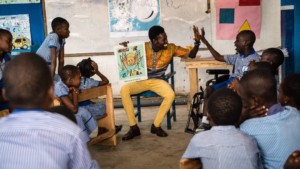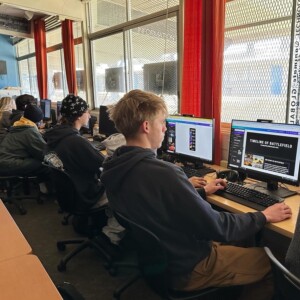Tertiary Education in the US is Broken

After the host announced that student debt in the U.S. topped $1 trillion, columnist Nicholas Kristof told CNN this morning that “Tertiary education in the US is broken.”
Sal Khan explained how the old formula—get a degree, get a good job, have a good life—is breaking down. More people are attempting degree programs but many of them didn’t receive adequate preparation in high school. They pay more for a degree and are now competing in a stagnant job market.
The CNN host showed a chart that suggested we are not doing any better than replicating social class in American—if your family makes more money you get a better education. Sal’s Khan Academy is an attempt to break that cycle by building the specific building blocks of college readiness with algebra help (and a lot more) when and where students need it.
To dramatically increase the percentage of the U.S. population holding a degree or meaningful certificate, preparation is clearly the most important issue. But as Kristof pointed out, the post-secondary system is broken: it’s very expensive, incentives for students and institutions are misaligned (if not perverse), and for the most part it is not well connected to the needs of the job market (as indicated by 3 million unfilled skilled jobs).
As noted during a brainstorming session on this topic yesterday, this is a very complicated set of problems combining personal behavior, institutional practices, and state and government policy.
I appreciate Texas Gov. Perry’s provocative challenge to leaders in his state to invent a $10,000 bachelor’s degree program. That sort of goal clarity requires breakthrough thinking. The solution set will likely require new learning technology, new consumer behaviors, and new incentives focused on speed, quality, and completion.
It’s interesting to note that the lower the price, the closer you get to do-it-yourself model and the more important student choices and behavior becomes. As David Brooks pointed out this week, individual behavior is a mixture of the rational (Moneyball) and intuitive (Blink).
Post-secondary choices—perhaps the most consequential and expensive decision in a young persons life—are made with little data and are a complicated function of tangible variables like location, entrance requirements, cost, and reputation, but also a set of intangible variables including social pressures, self-esteem, felt need, and life circumstances. Post enrollment behaviors are also a complicated mixture of motivation, engagement, convenience, perceived benefit, and family influences.
About ten years ago we passed an important threshold in human history where anyone with a broadband connection can learn almost anything almost anywhere. So why isn’t everyone learning everything? New tools that organize knowledge and make learning easier and more engaging are gaining traction and beginning to impact formal education—Khan Academy being the most notable example.
In DIY U, Anya Kamenetz, outlined the rise of informal and nontraditional post-secondary education. She, like Kristof, makes a compelling case that tertiary education is broken but that emerging alternatives are promising.
Given the complexity of boosting college completion rates, change efforts attacking the problem need to be rather comprehensive. They may include:
1. Market signaling: rewarding some promising models and ideas.
2. Support for R&D networks: a mixture of new and existing organizations that that agree to pilot low cost degree/certificate programs
3. An advocacy effort (the post-secondary equivalent of DigitalLearningNow.com) that encourages funding based on speed, quality, and completion.
4. Demand pull: organizing groups of employers to recognize new certificate/badge programs.
We need more college graduates particularly in science, math and engineering. We need to make degrees and certificates much more affordable. Achieving this important goal will require support for bottoms up and top down change and the work of social, tech and policy entrepreneurs. It’s time to push.
First published on Huffington Post








Tressie
Status competition theory 101: expansion of higher ed in an occupational de-coupled economy like the U.S. will only lead to greater stratification not greater mobility.